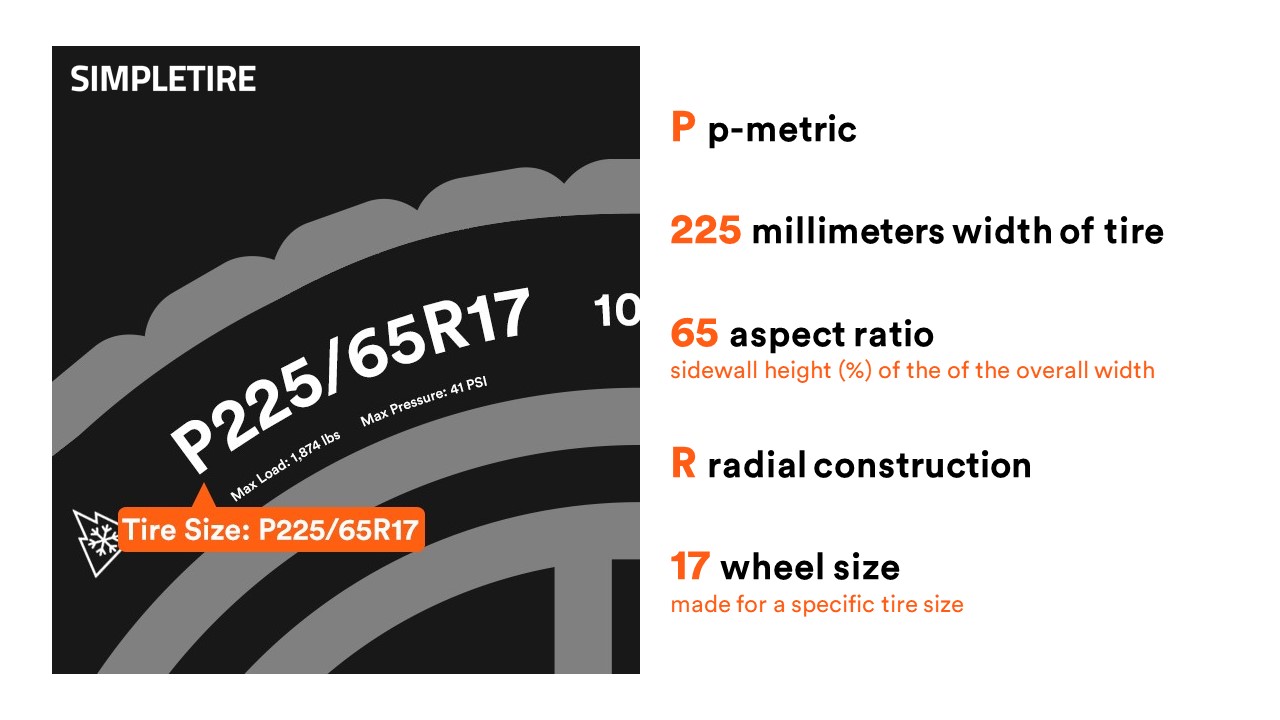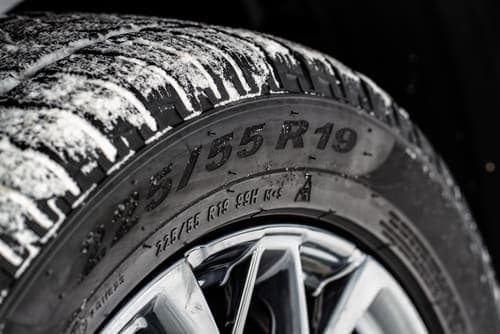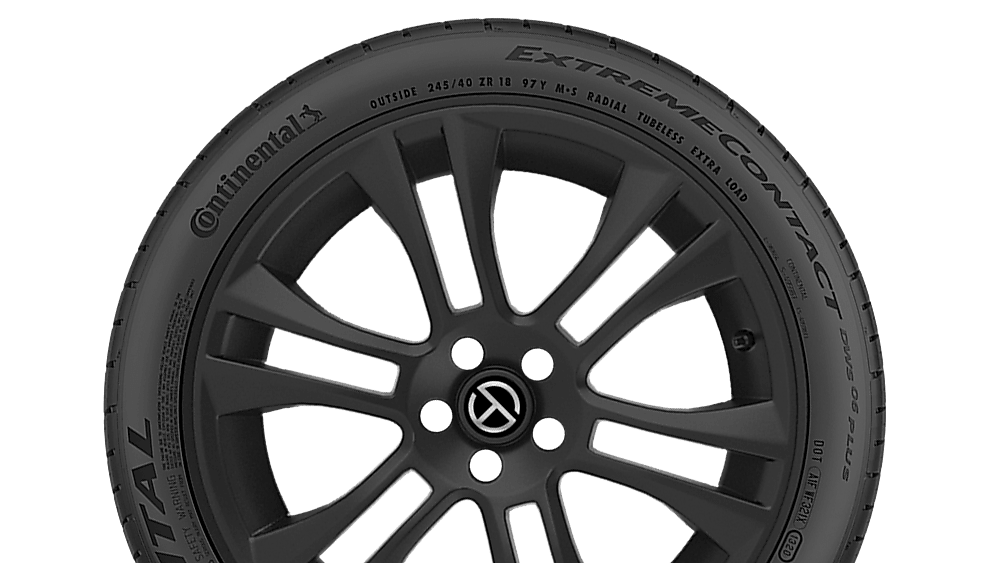Tire Buying Guides
Best price guarantee
Tire replacement coverage
24/7 roadside assistance
Easy returns

Understanding tire size is essential for ensuring your vehicle's safety, performance, and longevity. The numbers and letters on your tire's sidewall provide important information about its specifications, including width, aspect ratio, construction type, and diameter.
Knowing how to read these numbers is vital when selecting new tires or checking the compatibility of your current ones. Choosing the right tire size can significantly impact your vehicle's handling, braking, and overall safety on the road.
In this article, we'll guide you through the process of decoding tire size numbers, explaining each component and its importance. By the end, you'll be equipped with the knowledge to make informed decisions when it comes to your vehicle's tires.
What is Tire Size?

Tire size is a set of numbers and letters found on your tire's sidewall that indicates the tire's specifications, including width, aspect ratio, construction type, and diameter. This information is important for ensuring that you choose the right tires for your vehicle's make, model, and year.
The tire size is typically represented in a format such as "P225/65R17 91S." Each component of this code provides specific details about the tire's dimensions and capabilities. Understanding these numbers and letters is essential for maintaining your vehicle's performance, safety, and efficiency.
Tire size directly impacts several aspects of your vehicle's performance:
- Handling: The right tire size ensures optimal handling and stability, allowing you to maintain control of your vehicle in various driving conditions.
- Braking: Properly sized tires provide adequate traction and braking performance, helping you stop safely and efficiently.
- Fuel efficiency: Choosing the correct tire size can contribute to better fuel economy by reducing rolling resistance and improving overall vehicle performance.
- Longevity: Using the recommended tire size helps prevent premature wear and tear, extending the life of your tires and saving you money in the long run.
When replacing your tires or upgrading to a different size, it's essential to consult your vehicle's owner's manual or seek guidance from a professional. Tire retailers like SimpleTire offer expert advice and resources to help you find the perfect fit for your vehicle, ensuring a safe and comfortable driving experience.
How to Read Tire Size Numbers

Start by looking at the sidewall of your tire—this is where you'll find the tire size information. These markings, often ignored, are essential for understanding the tire's particular characteristics. By interpreting these codes, you acquire knowledge about the tire's dimensions, profile, type, and compatible wheel size.
Tire Width
The initial number indicates the tire's width in millimeters. For example, a tire marked "P225/65R17" measures 225 millimeters wide. This width measurement spans across the tire from one side to the other.
- Key Insight: A broader tire can enhance grip and stability, though it might affect fuel efficiency and comfort.
Aspect Ratio
Following the width, you'll see a number after a slash—this is the aspect ratio. It indicates the sidewall's height as a percentage of the tire's width. In "P225/65R17," the "65" signifies the height is 65% of the width.
- Key Insight: Lower aspect ratios often provide better handling, whereas higher ratios can offer a more cushioned ride.
Construction Type
Next, a letter identifies how the tire is constructed. The "R" in "P225/65R17" denotes radial construction, the prevalent type for most vehicles today. Radial tires have layers that extend radially from the center, boosting strength and longevity.
- Alternative Types: "D" for Diagonal and "B" for Bias Ply are less common but still exist in specialized applications.
Wheel Diameter
You’ll then find the wheel diameter listed, which shows the size of the wheel the tire fits. In "P225/65R17," the "17" refers to a 17-inch wheel. Choosing the correct wheel diameter ensures the tire fits your vehicle properly.
- Key Insight: Using the wrong wheel diameter can lead to handling difficulties, uneven wear, or damage to your vehicle.
By learning these tire size numbers, you empower yourself to select the right tires, optimizing your vehicle’s performance and safety.
1. Tire Width
The measurement of tire width plays a pivotal role in determining a tire's compatibility and performance. This metric, expressed as the first three digits in the tire size code, is measured in millimeters from one sidewall to the other. For example, if a tire is labeled "P225/65R17," it denotes a width of 225 millimeters.
Tire width affects numerous factors, such as vehicle handling, road grip, and comfort during rides. Opting for a wider tire often results in improved road contact and enhanced stability, beneficial for sporty driving or challenging terrains. However, these tires might generate more noise and potentially decrease fuel economy due to the increased surface area in contact with the road.
Key Considerations
- Vehicle Specifications: It's important to adhere to the manufacturer's recommended tire width for optimal performance and safety. An inappropriate width can lead to handling difficulties and safety concerns.
- Driving Conditions: Assess your typical driving environment. While wider tires can increase performance and grip, narrower options may better suit daily commutes by offering improved fuel efficiency.
- Wheel Compatibility: Ensure that the tire width is suitable for the wheel to prevent issues like improper seating or uneven tread wear. Proper alignment between tire and wheel width is necessary to maintain safe and effective contact with the road.
By understanding tire width and its implications, you can select tires that meet your driving demands and maintain your vehicle’s efficiency and safety standards.
2. Aspect Ratio
Aspect ratio is a vital element of tire specification, appearing right after the width figure. This value, located after the slash mark, describes the tire's sidewall height as a fraction of its width. For example, in a tire designated "P225/65R17," the "65" demonstrates that the sidewall height is 65% of the tire's width.
When a tire has a lower aspect ratio, this generally means the sidewall is shorter, which can improve steering precision and responsiveness by minimizing sidewall flex. This feature is often sought after in performance vehicles where enhanced control is essential. However, the trade-off is typically a firmer ride, as the reduced sidewall height provides less cushioning from road bumps.
On the other hand, a higher aspect ratio indicates a taller sidewall, which tends to absorb road irregularities better, resulting in a more comfortable ride. Such tires are often preferred in vehicles where comfort and load capacity are crucial, like family sedans or light trucks. The increased sidewall height can also offer additional protection against road hazards, minimizing the risk of damage to both tire and rim.
Considerations for Aspect Ratio
- Driving Style: If you value precise handling, opt for a lower aspect ratio. For those who prioritize comfort, especially on long drives, a higher aspect ratio may be more suitable.
- Vehicle Type: Evaluate your vehicle’s purpose and design. Performance cars benefit from lower aspect ratios, while SUVs and family vehicles might favor higher ones for enhanced comfort and durability.
- Road Conditions: Consider the roads you frequently travel. Rough or uneven surfaces might require a higher aspect ratio to ensure a smoother ride and reduce potential tire or wheel damage.
Understanding aspect ratio allows drivers to fine-tune their tire choices to match their driving needs, balancing performance with comfort to ensure their vehicle operates at its best.
3. Construction Type
Tire construction type is a key aspect in understanding a tire’s build and performance. Following the aspect ratio, a letter in the tire size code specifies the construction type: "R" for Radial, "D" for Diagonal, and "B" for Bias Ply. This letter provides insight into the tire's internal framework and its impact on driving dynamics.
Radial tires, indicated by the "R," are the standard for most modern vehicles. In these tires, the cord plies are arranged at 90 degrees to the direction of travel, running across the tire from bead to bead. This configuration results in flexible sidewalls and a broad footprint on the road, which improves traction and comfort. Radial tires are widely used due to their long-lasting performance, fuel efficiency, and ability to deliver a comfortable ride, making them suitable for passenger cars and many light trucks.
Diagonal or bias ply tires, marked with a "D," have plies that run diagonally across the tire, intersecting each other. This construction provides a robust, durable structure, ideal for vehicles that need enhanced resistance to impacts and punctures. While less common today, bias ply tires are still found in certain niche applications, such as vintage cars, trailers, and some heavy-duty machinery.
Understanding construction type is crucial when choosing tires for specific driving needs and vehicle requirements. When deciding between radial and bias ply tires, evaluate factors like road conditions, vehicle use, and performance expectations. Each type offers unique benefits, and selecting the appropriate one can greatly influence your vehicle's handling and comfort.
4. Diameter
The tire diameter refers to the size of the wheel that the tire is designed to fit, specified in inches. This number, found after the construction type, plays a crucial role in ensuring the tire fits correctly on the wheel. For instance, a tire labeled "P225/65R17" would fit a wheel that measures 17 inches in diameter.
Choosing the correct diameter is paramount for preserving the vehicle's handling and performance. An incorrect match can lead to improper tire installation, potentially causing vibrations or uneven tread wear. Additionally, using a tire with the wrong diameter may alter the vehicle's calibrated systems, such as speedometer accuracy, due to changes in the tire's overall circumference.
Key Points on Diameter
- Precision Match: Ensure the tire’s diameter precisely aligns with the wheel's size. Mismatches can disrupt driving dynamics and safety.
- Performance Considerations: The appropriate diameter maintains the vehicle’s intended ride height and suspension setup, which is critical for handling and braking effectiveness.
- Adhering to Specifications: Following the recommended diameter supports the vehicle's systems, like traction control and anti-lock brakes, which rely on specific tire dimensions for optimal function.
Selecting a tire with the correct diameter is essential not only for fitment but also for maintaining the intended driving experience. Ensuring this alignment with your vehicle's specifications helps uphold its performance and safety standards on the road.
5. Load Index
The load index on a tire is a key metric indicating how much weight the tire can safely carry when fully inflated. This numerical code, found at the end of the tire size sequence, translates to a specific weight capacity that is detailed in load index charts. For example, a tire marked "P225/65R17 95H" includes a load index of 95, which equates to a precise load-bearing capability.
Proper understanding of the load index is vital for maintaining vehicle safety and performance. Tires with a higher load index are designed to support heavier loads, making them ideal for vehicles that regularly transport significant weight or engage in towing. Conversely, using tires with a lower load index than specified can result in excessive strain on the tires, leading to potential failures and safety hazards.
Importance of Load Index
- Safety Assurance: Ensuring the tire's load index matches the vehicle's requirements prevents overloading, which can lead to tire failure and loss of control.
- Performance Optimization: The correct load index helps maintain the vehicle's handling and braking efficiency by supporting the intended weight distribution.
- Tire Durability: Using the recommended load index aids in even weight distribution across the tire, reducing wear and extending its lifespan.
Selecting tires with the appropriate load index is essential for achieving a balance between safety, performance, and durability. Always refer to your vehicle’s manual or consult a tire specialist to confirm the suitable load index for your vehicle to ensure your tires can handle your driving demands effectively.
6. Speed Rating
The speed rating, marked by a letter at the end of the tire's size description, signifies the top speed a tire can safely maintain under optimal conditions. This classification is crucial for understanding how the tire will perform at various speeds while ensuring stability and control. For instance, a tire with a speed rating of "H" is engineered to sustain speeds up to 130 mph.
This rating results from stringent testing conducted to evaluate the tire's capacity to handle the stress and heat generated during high-speed driving. Each letter represents a specific speed range, beginning with "L" for 75 mph and extending to "Y" for speeds up to 186 mph. The speed rating not only reveals the tire's maximum speed potential but also provides insights into its overall performance characteristics, such as cornering ability and ride quality.
Understanding Speed Ratings
- Performance Match: Select tires with a speed rating that aligns with your vehicle's design specifications to ensure they can support the vehicle's performance demands.
- Driving Environment: Evaluate your usual driving conditions when deciding on a speed rating. Higher speed ratings generally offer superior handling but might compromise comfort and wear resistance.
- Safety Consideration: Operating tires beyond their rated speed can lead to diminished performance and a higher risk of failure. Adhering to the appropriate speed rating is essential for maintaining safety and vehicle dynamics.
Choosing the correct speed rating is vital for aligning your tire's capabilities with your driving needs and conditions, ensuring a balanced approach to performance and safety.
Tips on Understanding Tire Specifications

Gaining a comprehensive understanding of tire specifications is essential for making informed choices about your vehicle's tires. This knowledge enhances safety and ensures that your tire selection aligns with your driving requirements.
1. Use a Tire Size Guide
Tire size guides offer detailed insights into tire specifications, breaking down the meanings behind numbers and letters on the sidewall. By referring to these guides, you can learn how each specification, from tire width to speed rating, affects vehicle performance. These guides are particularly useful for visual learners, providing diagrams and charts that make it easier to grasp complex information about tire dimensions and their implications for your vehicle's dynamics.
2. Consult a Professional
When in doubt about tire compatibility or specifications, turning to a tire expert at SimpleTire can provide clarity and reassurance. Professionals have the expertise to analyze your vehicle's needs and recommend tires that align with your driving habits and conditions. Their insights can prevent costly mistakes and ensure that your tires meet industry standards. By consulting with a professional, you gain access to advice tailored to your specific situation, ensuring that your vehicle operates safely and efficiently.
3. Regularly Inspect Tire Size Numbers
Regular inspections of the tire size numbers on your tires help maintain optimal performance and safety. This practice ensures that the tires you use match your vehicle's requirements and are suitable for your driving environment. By routinely checking these numbers, you can address any discrepancies early, preventing issues like uneven wear or handling problems. Keeping an eye on tire size numbers safeguards your vehicle against potential mismatches that could compromise its performance.
By understanding tire size numbers, you can make informed decisions when selecting tires that match your vehicle's specifications and driving needs. At SimpleTire, we are committed to helping you find the perfect tires for your vehicle, offering a wide selection from top brands and expert guidance throughout the process. Shop for tires online with us and experience the convenience of finding the best deals from the comfort of your home.
Ready to find the perfect tires?
Search By